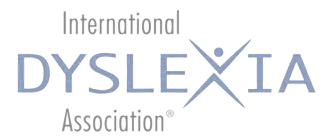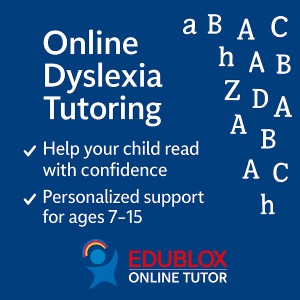
Dyslexia is one of the most common learning disabilities among children, affecting their ability to read, write, and spell despite adequate instruction and exposure to language. Dyslexia in children is not caused by low intelligence or lack of effort. Instead, it arises from neurobiological differences that affect how the brain processes written language. Early identification and targeted support can make a world of difference in helping children with dyslexia reach their full potential.
.
Table of contents:
- What is dyslexia?
- How common is dyslexia in children?
- Causes and risk factors
- Early warning signs: Preschool years
- Signs in school-aged children
- High school and beyond
- Diagnosis and assessment
- Interventions and accommodations
- Dyslexia in children explained to children
- Moving forward
What is dyslexia?
Dyslexia is a neurodevelopmental difference that affects how the brain processes written and spoken language. It falls under the umbrella of “specific learning disorders” alongside dysgraphia (writing difficulties) and dyscalculia (math difficulties). Dyslexia is not a visual problem, nor is it linked to poor motivation or ability. Instead, it reflects variation in how individuals learn to read—particularly in how they connect letters to sounds, blend those sounds into words, and recognize words efficiently.
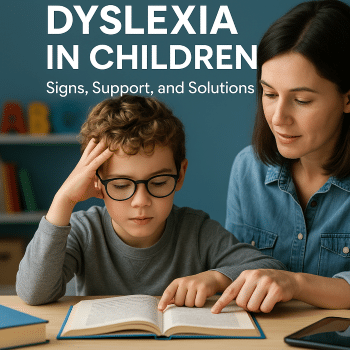
Many children with dyslexia experience difficulty with phonological processing—the ability to identify and manipulate the sounds in language—but not all. Some show weaknesses in rapid automatized naming (RAN), working memory, or visual-sequential processing. According to Wolf and Bowers (1999), deficits in RAN can contribute independently to reading difficulties, while those with deficits in both phonological and naming speed pathways, which they termed “double deficit,” experience the most profound and persistent reading difficulties.
These challenges can make reading slower and more effortful, which in turn impacts spelling, comprehension, writing fluency, and confidence.
How common is dyslexia in children?
While only around 5-7% of the population is formally diagnosed with dyslexia, many experts estimate that up to 20% of people may exhibit symptoms that significantly impact reading and learning. Dyslexia is the most common specific learning disability and accounts for 80–90% of those diagnosed with learning disorders.
Though dyslexia occurs equally in boys and girls, boys are often more likely to be referred for evaluation due to associated behaviors such as inattentiveness or acting out in class.
Historically, dyslexia was associated with a discrepancy between IQ and reading performance; however, modern neuroscience has shown that this is an inaccurate representation. Brain imaging studies confirm that the phonological difficulties seen in dyslexia are independent of IQ (Tanaka et al., 2011). Children of all intellectual levels can struggle with dyslexia.
Causes and risk factors
Dyslexia is highly heritable and often runs in families (DeFries et al., 1978). If one parent has dyslexia, their child has a 30% to 50% chance of also developing it. Brain scans of children with dyslexia show distinct patterns of activity and less efficient neural pathways involved in reading. These neurological differences are not caused by poor instruction or lack of exposure to books.
Naturally, environmental factors can interact with genetic risk. A child growing up in a home with limited access to books, little reading aloud, or exposure to toxic substances (like lead or nicotine) may face additional risks. Similarly, hearing impairments or untreated speech and language delays in early childhood can increase the likelihood of developing reading difficulties later on.
Early warning signs: Preschool years
Although a formal diagnosis usually isn’t made until age six or older, many signs of dyslexia appear in the preschool years. Children at risk may:
- Be slow to talk or have delayed speech development
- Struggle with learning and repeating nursery rhymes
- Mispronounce longer or complex words (e.g., “flutterby” instead of “butterfly”)
- Confuse direction words (up/down, left/right)
- Mix up sequences like numbers, days of the week, or classroom routines
- Appear inattentive or inconsistent in listening and behavior
- Have difficulty following multi-step directions unless broken into small parts
- Forget familiar names, colors, or basic vocabulary
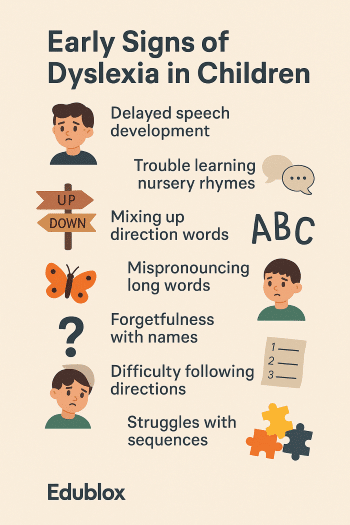
These behaviors can occur in many children, but when they persist and cluster together, they may suggest a specific learning difference. It’s advisable to raise concerns with a pediatrician, speech-language pathologist, or early childhood educator. Early support can build language skills and reduce frustration as formal schooling begins.
Signs in school-aged children
Dyslexia often becomes more apparent once a child starts formal literacy instruction. Typical signs during the early primary school years include:
- Difficulty learning letter-sound associations
- Reversing letters like b/d or numbers like 6/9
- Inconsistent phonetic spelling (e.g., “hrbr” for “harbor”)
- Trouble sounding out unfamiliar words
- Labored, slow reading with limited expression
- Avoidance of reading aloud in class
- Poor handwriting and disorganized written work
- Struggling to follow instructions or copy from the board
Children may also exhibit strengths in oral discussion or creative problem-solving but fall behind in written assessments. Teachers often describe these students as having a “spiky profile”—strong in some areas and significantly weaker in others.
By middle to upper elementary school, children with dyslexia may begin to internalize their struggles, especially as reading becomes central to all academic subjects. Without intervention, their self-esteem can suffer.
High school and beyond
Dyslexia doesn’t go away with age. In adolescence, it often shifts from obvious decoding problems to broader issues like:
- Slow or hesitant reading, especially out loud
- Poor spelling despite repeated exposure to words
- Disorganized or overly brief written responses
- Avoidance of reading-heavy tasks
- Difficulty learning foreign languages
- Mental fatigue from academic effort
- Emotional challenges, including anxiety, frustration, or withdrawal
Teens with dyslexia may also develop coping mechanisms—some helpful, some not. They might avoid subjects they fear, develop perfectionism, or exhibit acting-out behaviors. Their abilities may be underestimated, especially if they work hard to “mask” their struggles.
Diagnosis and assessment
Dyslexia is formally diagnosed through a comprehensive evaluation by an educational psychologist, speech-language pathologist, or reading specialist. This assessment typically includes:
- Phonological awareness
- Word decoding and word recognition
- Oral language and vocabulary
- Reading fluency and comprehension
- Spelling and writing
- Working memory, attention, and processing speed
A comprehensive picture of a child’s strengths and challenges helps determine the most effective course of support. However, a formal diagnosis is not a prerequisite for help. Schools can—and should—begin interventions based on observed need, especially during the critical early years of learning.
Interventions and accommodations
Dyslexia can be substantially improved with the right instruction and strategies. Research confirms that early, explicit, and structured teaching in reading and spelling, combined with support for cognitive weaknesses, can rewire neural pathways and improve learning outcomes.
Key components of effective intervention include:
- Systematic instruction in phonics and decoding: Directly teaching how letters represent sounds and how to blend those sounds into words.
- Multisensory methods: Utilizing a combination of visual, auditory, and kinesthetic cues to enhance memory and learning.
- Reinforcement and overlearning: Regular review helps solidify skills, particularly in areas such as spelling and word recognition.
- Cognitive skill building: Strengthening memory, sequencing, attention, and rapid naming supports reading fluency and comprehension.
- Small group or one-on-one sessions: Personalized pacing and immediate feedback are critical for struggling learners.
Accommodations in the classroom:
Beyond instruction, accommodations help level the playing field. These may include:
- Extra time on tests
- Access to audiobooks or text-to-speech tools
- Options to type or dictate rather than handwrite
- Reducing the volume of written work when possible
- Avoiding forced oral reading in front of peers
Individualized Education Plans (IEPs) or 504 Plans can formalize these supports in schools. However, even informal adjustments by a compassionate teacher can make a big difference.
Emotional and social support:
The emotional toll of dyslexia is often underestimated. Children who struggle to keep up with reading often feel embarrassed, frustrated, or ashamed. They may believe they’re not smart, especially when compared to peers who read effortlessly.
To foster resilience and self-confidence:
- Celebrate effort, not just accuracy
- Highlight the child’s strengths—art, music, storytelling, empathy, or logic
- Discuss dyslexia openly and honestly
- Share stories of successful people with dyslexia (e.g., Steven Spielberg and Whoopi Goldberg)
- Help your child develop interests and talents outside of school
Children with dyslexia benefit enormously from adults who believe in them, advocate for their needs, and see them as more than their reading struggles.
Dyslexia in children explained to children
This picture story is designed for parents to use with their child. Each slide uses simple images to explain what dyslexia is, how common it is, the signs to look for, how it is diagnosed, and how a child can be helped. Sit with your child, talk through each image, and use the pictures to make the ideas easy to understand. The goal is to help them to feel informed, supported, and hopeful.
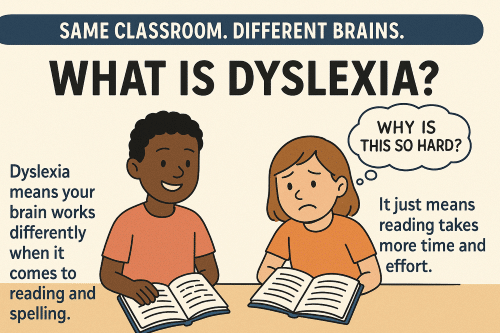
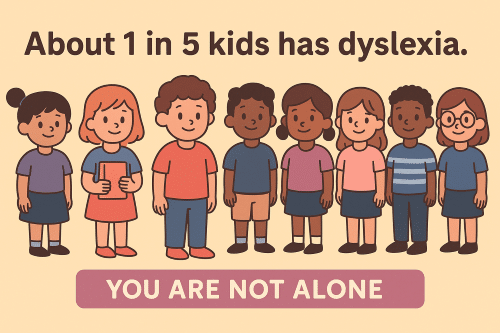
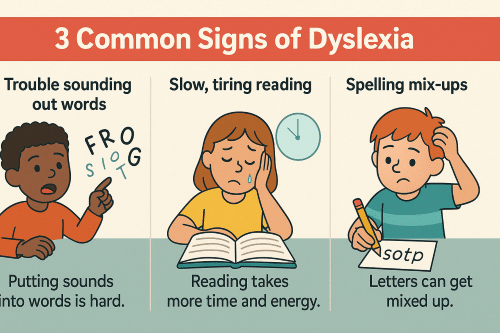
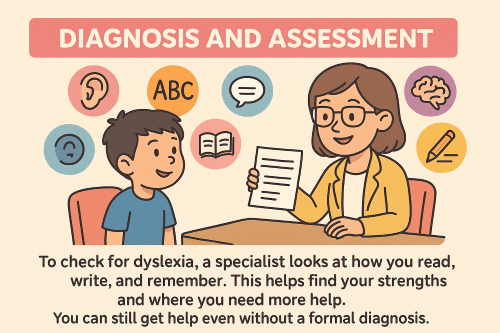
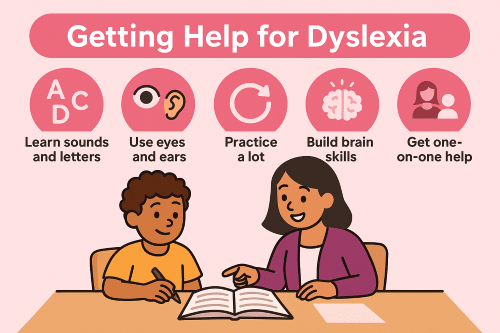
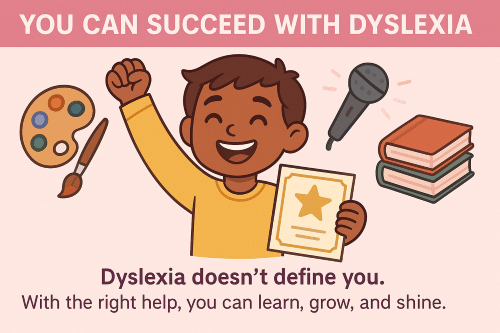
Moving forward
Dyslexia does not define a child’s future. With the right mix of understanding, early support, cognitive intervention, and emotional encouragement, children with dyslexia can learn to read—and go on to thrive academically, creatively, and socially.
If you suspect dyslexia, don’t wait. Talk to your child’s teacher, pediatrician, or a qualified learning specialist. The earlier the intervention, the better the outcome—not only for reading but for self-esteem and lifelong learning.
Edublox offers explicit and systematic instruction in reading combined with cognitive training to help students overcome symptoms of dyslexia. We work with families across the United States, Canada, Australia, and beyond. Book a free consultation to explore how we can support your child’s learning journey.
References for Dyslexia in Children: Signs, Support, and Solutions:
- DeFries, J. C., Singer, S. M., Foch, T. T., & Lewitter, F. I. (1978). Familial nature of reading disability. The British Journal of Psychiatry, 132(4), 361–7.
- Tanaka, H., Black, J. M., Hulme, C., Stanley, L. M., Kesler, S. R., Whitfield-Gabrieli, S., … Hoeft, F. (2011). The brain basis of the phonological deficit in dyslexia is independent of IQ. Psychological Science, 22(11), 1442-1451.
- Wolf, M., & Bowers, P. G. (1999). The double-deficit hypothesis for the developmental dyslexias. Journal of Educational Psychology, 91(3), 415–438.
Dyslexia in Children: Signs, Support, and Solutions was authored by Sue du Plessis (B.A. Hons Psychology; B.D.), an educational specialist with 30+ years experience in learning disabilities, and Dylan Arslanian (B.A. Hons Linguistics, Cambridge DELTA). Medically reviewed by Dr. Zelda Strydom (MBChB).
Edublox is proud to be a member of the International Dyslexia Association (IDA), a leading organization dedicated to evidence-based research and advocacy for individuals with dyslexia and related learning difficulties.
